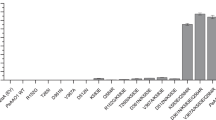Abstract
A hydroxynitrile lyase (HNL) from the millipede Chamberlinius hualienensis has high potential for industrial use in the synthesis of cyanohydrins. However, obtaining sufficient amounts of millipedes is difficult, and the production of the Chamberlinius hualienensis HNL (ChuaHNL) in E. coli has not been very successful. Therefore, we investigated the conditions required for high-yield heterologous production of this enzyme using Pichia pastoris. When we employed P. pastoris to express His-ChuaHNL, the yield was very low (22.6 ± 3.8 U/L culture). Hence, we investigated the effects of ChuaHNL codon optimization and the co-production of two protein disulfide isomerases (PDIs) [from P. pastoris (PpPDI) and C. hualienensis (ChuaPDI1, ChuaPDI2)] on His-ChuaHNL production. The productivity of His-ChuaHNL was increased approximately 140 times per unit culture to 3170 ± 144.7 U/L by the co-expression of codon-optimized ChuaHNL and PpPDI. Moreover, we revealed that the N-glycosylation on ChuaHNL had a large effect on the stability, enzyme secretion, and catalytic properties of ChuaHNL in P. pastoris. This study demonstrates an economical and efficient approach for the production of HNL, and the data show that glycosylation has a large effect on the enzyme properties and the P. pastoris expression system.





Similar content being viewed by others
References
Asano Y, Tamura K, Doi N, Ueatrongchit T, H-Kittikun A, Ohmiya T (2005) Screening for new hydroxynitrilases from plants. Biosci Biotechnol Biochem 69:2349–2357. https://doi.org/10.1271/bbb.69.2349
Bradford MM (1976) A rapid and sensitive method for the quantitation of microgram quantities of protein utilizing the principle of protein-dye binding. Anal Biochem 72:248–254
Caruso CS, de Fatima Travensolo R, de Campus Bicudo R, de Macedo Lemos EG, Ulian de Araujo AP, Carrilho E (2009) alpha-Hydroxynitrile lyase protein from Xylella fastidiosa: cloning, expression, and characterization. Microb Pathog 47:118–127. https://doi.org/10.1016/j.micpath.2009.06.007
Chang S-W, Lee G-C, Shaw J-F (2006) Codon optimization of Candida rugosa lip1 gene for improving expression in Pichia pastoris and biochemical characterization of the purified recombinant LIP1 lipase. J Agric Food Chem 54:815–822. https://doi.org/10.1021/jf052183k
Dadashipour M, Asano Y (2011) Hydroxynitrile lyases: insights into biochemistry, discovery, and engineering. ACS Catal 1:1121–1149. https://doi.org/10.1021/cs200325q
Dadashipour M, Ishida Y, Yamamoto K, Asano Y (2015) Discovery and molecular and biocatalytic properties of hydroxynitrile lyase from an invasive millipede, Chamberlinius hualienensis. Proc Natl Acad Sci USA 112:10605–10610
Fukuta Y, Nanda S, Kato Y, Yurimoto H, Sakai Y, Komeda H, Asano Y (2011) Characterization of a new (R)-hydroxynitrile lyase from the Japanese apricot Prunus mume and cDNA cloning and secretory expression of one of the isozymes in Pichia pastoris. Biosci Biotechnol Biochem 75:214–220. https://doi.org/10.1271/bbb.100187
Gao Z, Li Z, Zhang Y, Huang H, Li M, Zhou L, Tang Y, Yao B, Zhang W (2012) High-level expression of the Penicillium notatum glucose oxidase gene in Pichia pastoris using codon optimization. Biotechnol Lett 34:507–514. https://doi.org/10.1007/s10529-011-0790-6
Hu S, Li L, Qiao J, Guo Y, Cheng L, Liu J (2006) Codon optimization, expression, and characterization of an internalizing anti-ErbB2 single-chain antibody in Pichia pastoris. Protein Expr Purif 47:249–257
Hussain Z, Wiedner R, Steiner K, Hajek T, Avi M, Hecher B, Sessitsch A, Schwab H (2012) Characterization of two bacterial hydroxynitrile lyases with high similarity to cupin superfamily proteins. Appl Environ Microbiol 78:2053–2055. https://doi.org/10.1128/AEM.06899-11
Ishida Y, Kuwahara Y, Dadashipour M, Ina A, Yamaguchi T, Morita M, Ichiki Y, Asano Y (2016) A sacrificial millipede altruistically protects its swarm using a drone blood enzyme, mandelonitrile oxidase. Sci Rep 6:26998. https://doi.org/10.1038/srep26998
Laemmli UK (1970) Cleavage of structural proteins during the assembly of the head of bacteriophage T4. Nature 227:680–685
Nuylert A, Ishida Y, Asano Y (2017) Effect of glycosylation on the biocatalytic properties of hydroxynitrile lyase from the passion fruit, Passiflora edulis: a comparison of natural and recombinant enzymes. ChemBioChem 18:257–265. https://doi.org/10.1002/cbic.201600447
Osbourn AE (1996) Preformed antimicrobial compounds and plant defense against fungal attack. Plant Cell 8:1821–1831. https://doi.org/10.1105/tpc.8.10.1821
Sinclair G, Choy FY (2002) Synonymous codon usage bias and the expression of human glucocerebrosidase in the methylotrophic yeast, Pichia pastoris. Protein Expr Purif 26:96–105
Tian G, Xiang S, Noiva R, Lennarz WJ, Schindelin H (2006) The crystal structure of yeast protein disulfide isomerase suggests cooperativity between its active sites. Cell 124:61–73
Wajant H, Effenberger F (1996) Hydroxynitrile lyases of higher plants. Biol Chem 377:611–617
Weis R, Gaisberger R, Gruber K, Glieder A (2007) Serine scanning: a tool to prove the consequences of N-glycosylation of proteins. J Biotechnol 129:50–61. https://doi.org/10.1016/j.jbiotec.2006.12.001
Wiedner R, Gruber-Khadjawi M, Schwab H, Steiner K (2014) Discovery of a novel (R)-selective bacterial hydroxynitrile lyase from Acidobacterium capsulatum. Comput Struct Biotechnol J 10:58–62. https://doi.org/10.1016/j.csbj.2014.07.002
Wildt S, Gerngross TU (2005) The humanization of N-glycosylation pathways in yeast. Nat Rev Micro 3:119–128. https://doi.org/10.1038/nrmicro1087
Yamaguchi T, Nuylert A, Ina A, Tanabe T, Asano Y (2018) Hydroxynitrile lyases from cyanogenic millipedes: molecular cloning, heterologous expression, and whole-cell biocatalysis for the production of (R)-mandelonitrile. Sci Rep 8:3051. https://doi.org/10.1038/s41598-018-20190-x
Zhao GJ, Yang ZQ, Guo YH (2011) Cloning and expression of hydroxynitrile lyase gene from Eriobotrya japonica in Pichia pastoris. J Biosci Bioeng 112:321–325. https://doi.org/10.1016/j.jbiosc.2011.06.015
Acknowledgements
We thank Dr. Yuko Ishida for analyzing the RNA sequence of C. hualienensis. This work was supported by ERATO (Exploratory Research for Advanced Technology Program), Asano Active Enzyme Molecule Project of Japan Science and Technology Agency (Grant No. JPMJER1102). This research was also supported in part by a grant-in-aid for Scientific Research (S) from The Japan Society for Promotion of Sciences (Grant No. 17H06169) to Y. Asano. The financial support given to A. Nuylert from Ministry of Education, Culture, Sport, Science and Technology (MEXT) of Japan is deeply appreciated.
Author information
Authors and Affiliations
Corresponding author
Additional information
Publisher's Note
Springer Nature remains neutral with regard to jurisdictional claims in published maps and institutional affiliations.
Electronic supplementary material
Below is the link to the electronic supplementary material.
Rights and permissions
About this article
Cite this article
Zhai, Z., Nuylert, A., Isobe, K. et al. Effects of codon optimization and glycosylation on the high-level production of hydroxynitrile lyase from Chamberlinius hualienensis in Pichia pastoris. J Ind Microbiol Biotechnol 46, 887–898 (2019). https://doi.org/10.1007/s10295-019-02162-w
Received:
Accepted:
Published:
Issue Date:
DOI: https://doi.org/10.1007/s10295-019-02162-w




